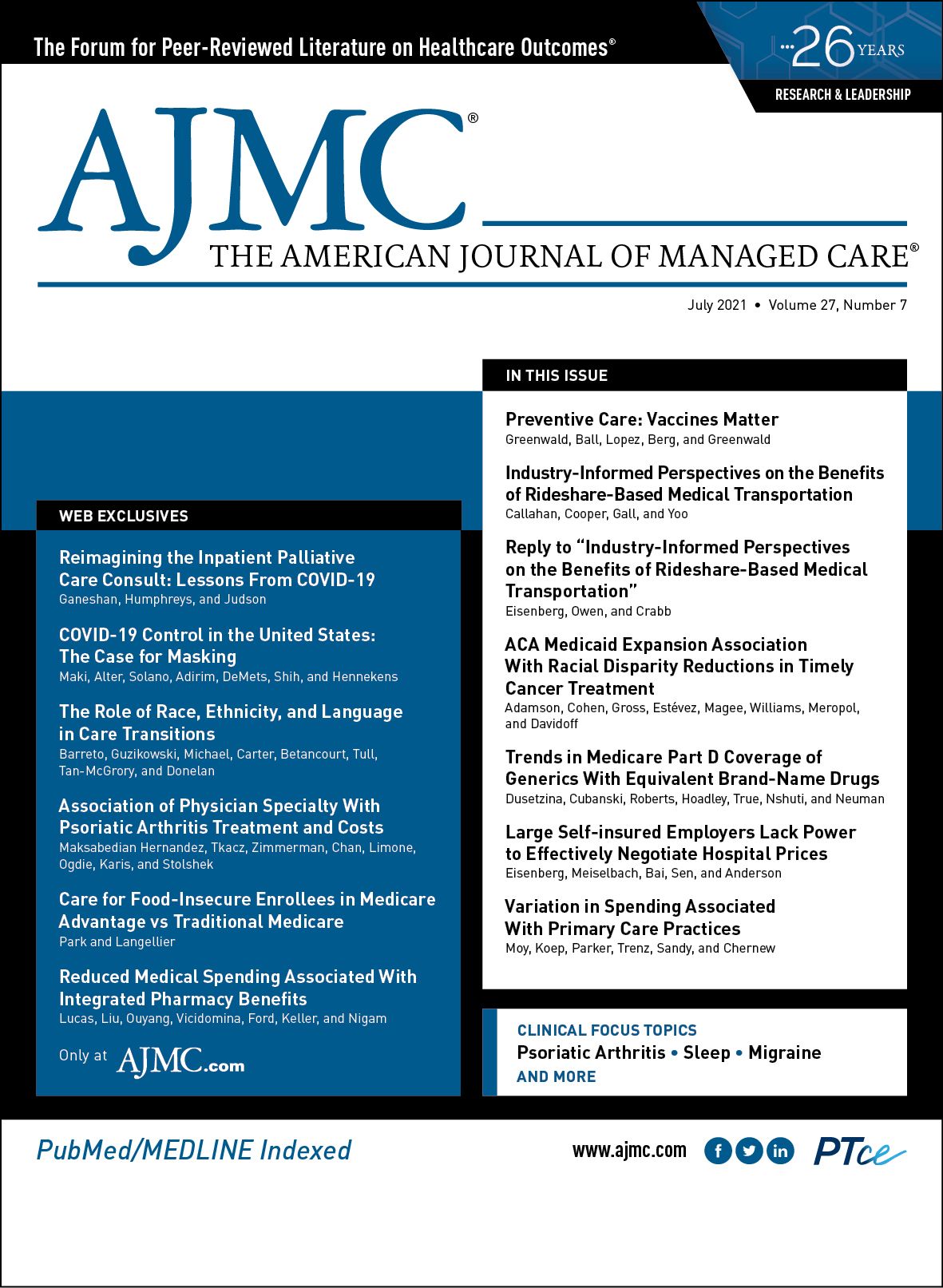- Center on Health Equity & Access
- Clinical
- Health Care Cost
- Health Care Delivery
- Insurance
- Policy
- Technology
- Value-Based Care
Preventive Care: Vaccines Matter
A database of information about more than 30,000 patients verified improved morbidity and mortality due to vaccines and preventive health care in prospective trials.
Am J Manag Care. 2021;27(7):269-270. https://doi.org/10.37765/ajmc.2021.88699
Takeaway Points
Preventive care and vaccines matter.
- Vaccines for influenza, pneumonia, and zoster contributed to less infection, lower hospitalization, and improved survival.
- Chewable 81-mg daily aspirin helped prevent deep vein thrombosis.
- No use of corticosteroids or narcotics at the nested site contributed to improved morbidity and mortality.
- Standard good clinical practice, including treatment of hypertension, diabetes, obesity, and high cholesterol, led to fewer major adverse cardiovascular events in a population 63 years and older who were followed for up to 7 years.
Preventive medical care can improve morbidity and mortality. This assessment included 28,105 patients with rheumatoid arthritis (RA) from prospective randomized trials. This group was chosen because they are prone to infection. Preventive care could influence outcomes.
Methods
Nested data from a single site were compared with global data in 39 pivotal studies using immune therapies for RA. Data were extracted from new drug applications (NDAs) submitted for FDA approval for tumor necrosis factor inhibitor (adalimumab, etanercept, certolizumab, and infliximab), Janus kinase inhibitor (tofacitinib, baricitinib, upadacitinib, and filgotinib), rituximab, abatacept, interleukin (IL) 1 (anakinra, canakinumab), and IL-6 (tocilizumab) therapy. The nested site participated in each study; entry criteria, age, concomitant medication, and intervention were identical. Safety results were gleaned from the FDA website.1 Safety data included death from any cause, and this evaluation explored death from major adverse cardiovascular events (MACE), pneumonia, and zoster. The nested site instituted 10 specific preventive care measures. These included (1) vaccination for influenza, pneumonia, and zoster; (2) hypertensive treatment for blood pressure greater than 140/90 mm Hg; (3) diabetes treatment if glycated hemoglobin A1C greater than 9%; (4) treatment for uric acid greater than 7 mg/dL; (5) statin therapy if low-density lipoprotein cholesterol greater than 120 mg/dL; (6) treatment if body mass index greater than 30, including visit with staff dietitian every 3 months; (7) chewable aspirin 81 mg/day; (8) daily prenatal vitamin with 1 mg folate (given to all patients to ensure 1-mg folate dose necessary when taking methotrexate); (9) daily sinus wash (NeilMed) to decrease upper respiratory infection; and (10) no use of corticosteroids or narcotics. All preventive measures were conducted at the nested site.
Results
The results are shown in the Table (A and B).
Zoster. Zoster incidence in trials decreased between 2005 and 2020. Key to this decline was Zostavax approval in 2006 and Shingrix approval in 2017. At the nested site, zoster vaccines for all started in 2006 and resulted in significantly less zoster incidence.
Pneumonia and death due to infection. There were 28,105 subjects in the global population and 924 subjects at the nested site.Pneumonia events were lower in the nested site than the global population (P < .004). All nested site subjects had influenza and pneumonia vaccination. Deaths due to infection were lower at the nested site (about one-third of deaths in all RA trials were due to pneumonia).
Mortality.There were 4469 global subjects and 154 at the nested site in a data set of older patients (aged 63-70 years) with long-term follow-up of 3 to 7 years. Mortality was less at the nested site in these older subjects (0.3% vs 2.8%; P < .007). In the shorter trials (6 months-2 years) with younger subjects, of the 28,105 global subjects and 924 in the nested site, overall mortality was not different.
MACE. MACE were numerically less at the nested site for the older population (followed 3-7 years): 0.5% vs 0.9% (P = .3).
Thrombotic events. The nested site had fewer thrombotic events (P < .03 in the longer follow-up trials); at the nested site, subjects took chewable aspirin 81 mg/d.
Conclusions
This is a causal inference study using prospective data from 39 trials. Vaccination is a likely explanation for less zoster, pneumonia, deaths due to infection, and mortality at the nested site. The lack of more data over 2 years limits efforts to measure reduction of MACE (through control of blood pressure, diabetes, cholesterol, and diet). Vaccines are clearly necessary in medical care for RA. Vetted data from NDAs can yield insight for health care. Preventive care yielded less mortality and less morbidity in these prospective controlled trials.
Author Affiliations: Desert Medical Advances (MoG, JB, SL, MB, MaG), Palm Desert, CA.
Source of Funding: No funding was provided for this data evaluation. All data are publicly available at www.fda.gov.
Author Disclosures: The authors report no relationship or financial interest with any entity that would pose a conflict of interest with the subject matter of this article.
Authorship Information: Concept and design (MaG); acquisition of data (MoG, JB, SL, MB, MaG); analysis and interpretation of data (MaG); drafting of the manuscript (MoG, JB, SL, MB, MaG); provision of patients or study materials (JB, SL, MB, MaG); administrative, technical, or logistic support (MoG); and supervision (JB).
Address Correspondence to: Maria Greenwald, MD, Desert Medical Advances, 72855 Fred Waring Dr, Ste A6-9, Palm Desert, CA 92260. Email: greenwald.maria@gmail.com.
REFERENCE
1. Drugs@FDA: FDA-approved drugs. FDA. Accessed September 25, 2020. https://www.accessdata.fda.gov/scripts/cder/daf/


